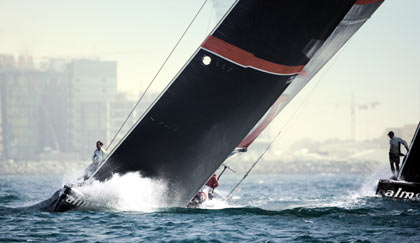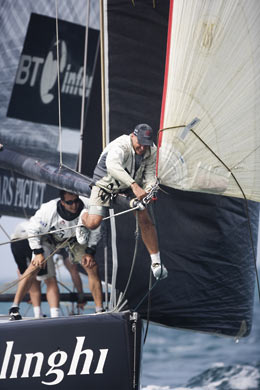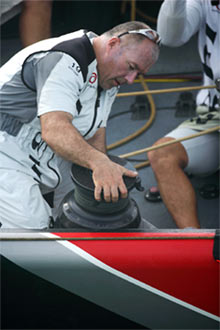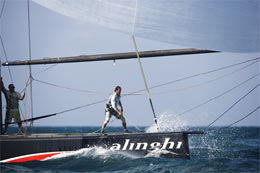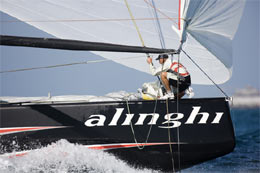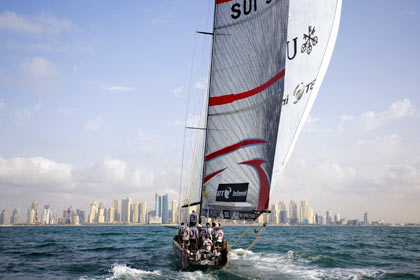|
|
||||||||||||||||||||||||||||||||
Going into the last day of racing of the UBS Defender Trial 2 on 19 February Ed Baird was leading Peter Holmberg 3-1. Racing had been cancelled the previous day, so Holmberg needed two wins from two starts to win the series. In the event of a tie the winner of the last race is declared the winner. Racing on the last day was delayed to allow the wind conditions to stabilize. The prevailing wind off the desert was battling with the sea breeze for dominance. This battle of the natural forces was a textbook demonstration of the first of three reasons given by Ernesto Bertarelli at the post-race press conference for his love of sailing: "Ultimately I think itís a beautiful sport because its one which relies solely on the forces of nature to work." The delay meant there was time only for a single race, so to keep things competitive the last race was announced as a double-point race.
Once out on the course there was the usual period where the boats were getting sails hoisted and checking setups. SUI-91 sported a completely black genoa during this time, but changed it to a more standard looking headsail prior to the pre-start. Closing in on race start time there was a slight delay in getting underway while SUI-91, helmed by Peter Holmberg, changed mainsails, hoisting one with SUI-75ís number. Whether this was due to problems with the 91 sail, a different cut better suited to the wind, an intentional de-tuning to provide a better match up with 64ís configuration, or just a deliberate ploy to confuse unseen spies will remain a mystery. Racing got underway in a fairly steady 12-15 knot breeze. After a bit of circling, the start was a split-tack affair with Holmberg crossing the line on port at the start boat end and Baird on starboard further down the line. A wind shift favored the left side of the course, turning the upwind leg into a bit of a drag race with both boats sailing out towards the starboard layline and then around the top mark with only five tacks between them, the delta being 1:10 to Baird. The downwind leg was livelier, with Holmberg throwing in several gybes, countered by Baird, before the two boats diverged. As the boats came back at each other a large wind shift led both boats to drop their spinnakers and complete the race with a few tacks to get to the finish line. When the wind changed, and genoas went back up, it appeared that 64 carried the spinnaker a lot higher into the wind than 91 did for a while. It was not apparent whether this was due to different local wind, the cut of the sail, or some other factor. Final result of the Race: Win to Baird by 35 seconds to take him to 4-1 for trial series #2.
During the time on the water Christian Karcher, Alinghi grinder and grinding coach, provided insights into the Alinghi team as well as giving a blow-by-blow commentary of the race. The biggest factor in the success of Alinghi is teamwork, Christian emphasized. He stressed that there is no A and B crew, but rather they work on a rotation basis so if anybody gets injured or is not at 100% then their replacement can slot into their position and already know how they interact with everyone else in that crew. When asked how well that had been achieved with such a diverse mix of nationalities, he said it had not been easy and took constant work. One of the challenges faced in shaping this unified team was the attitudes of people from different countries and cultures. As an example Christian compared what the typical responses of the Kiwiís in the team would be to those of Jochen 'The Schuemann-nator' Schuemann to the question of "What is the plan for tomorrow?" The Kiwis: "Who cares, letís go have a beer." JS: "Thereís a meeting at 8:35, followed by...and then...and then...."
Christian was full of admiration for Schuemann, the way he brings a steadying influence to the team and is always completely calm, thinking of the next three moves while all around him is chaos. He also highlighted the differences between being a defender this Americaís Cup compared to the previous four heís been involved in as a challenger: "You feel the whole world is against youÖ.You look in the mirror in the morning and see the only other person who wants us to win." Following the final race for Round 2 of the UBS Defender Trials there was a short prize giving ceremony followed by a press conference. At the press conference the announcement was made that the intent of the trial series was to name a helmsman and afterguard for the Louis Vuitton Act 13 to be held in Valencia in April. However the announcement was that after two race series it was too close to call and the helmsman would not be named. Instead Alinghi wants to maintain the high level of sailing and healthy in-house competition when they relocate back to Valencia in order to keep on top of the game. The importance of maintaining this competition is obvious given the fleet races in Act 13 are the last opportunity for the Alinghi team to engage in serious racing against the challenging syndicates before the Americaís Cup races in June. The challengers have the races of the Louis Vuitton Cup to continually gauge themselves against the opposition, which the defender needs to replicate to ensure they are at the top of the game when the gun goes. When asked what benefit these fleet races have and whether we would really see the true form of the defender and challengers Ernesto Bertarelli responded, "Experience tells that everybody shows everything because itís so important to win for the morale of the team....If you can come out of Act 13 with a strong feeling, with a motivated squad, it's worth taking." Design and technology play a big role in the Americaís Cup, which was Ernestoís second reason for his love of sailing: "Itís a very modern and very exciting sport because itís a mechanical sport....Itís about building the fastest possible machine out of carbon, titanium, hydraulics, fibre-optics, GPS, you name it." One design factor that is apparent when comparing boats of challengers and defender, and even within each syndicate at different times, is the presence and disappearance of bowsprits. When questioned about their appearance and subsequent disappearance on SUI 64 and 91 Grant Simmer and Brad Butterworth had the following to say: GS: "We've been trying both ways (with and without bowsprits)."
Q: How much does it affect the handling of the boat?" GS: "It changes the way your crew work. We've been making some changes to the way we handle the spinnakers and gennakers to lead towards not using bowsprits, so that's where we are at the moment. Itís not a final decision but ......." BB: "We've had them on, take them off, had them on, take them off. We're trying to work out whether we need them or not. Hopefully we won't need to use them." Q. What does the bowman think of them? BB: "He doesn't like them." And no, they are not retractable. A big difference between Americaís Cup efforts now compared to 10-20 years ago is the much longer duration of the campaign. The campaigns today span several years compared to only one, or even less, and with the Louis Vuitton Acts this campaign has already had more sailing than previous LV/AC events. With the extra sailing and testing goes a lot more hardware. How many sails and rigs will get built in a four-year campaign? Grant Simmer answered, "We would do four rigs. In the common headsails, the Code 2 and Code 1, we are up to 25 new headsails in each code and about 15 mains." During the acts SUI-75 was seen out on the water racing against the challengers, yet a modified 64 is being used as the benchmark for 91. Brad Butterworth commented, "64 is a better boat now than 75....Itís a pretty nice boat." These modifications to the existing fleet, testing in Dubai prior to Christmas, and intense in-house racing during January and February have allowed a lot of data collection for refinement of SUI-100ís design, due to be launched in late March, providing benchmarks for getting it up to speed quickly.
While out on the water Christian Karcher emphasized the importance of melding the team into a single entity. Ernesto reinforced this at the press conference as this third reason for his love of sailing, comparing it to football, where "every position on the team is extremely important, but at any given time only one player has the ball. With sailing all 17 people on the boat have to be on the ball, rather than just one." Alinghi are returning to Valencia satisfied with what they have achieved in Dubai, happy with the exposure they have given sailing in the Gulf region and primed to mix it up with the challengers in Louis Vuitton Act 13. Will these preparations, design development, training and continued in-house competition be sufficient for Alinghi to successfully defend the Americaís Cup in Valencia? For that weíll have to wait until June. Bring it on!
Additional Links of Interest: CupInfo visits with Alinghi's Christian Karcher Alinghi Team site: Alinghi.com |
